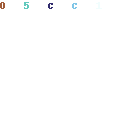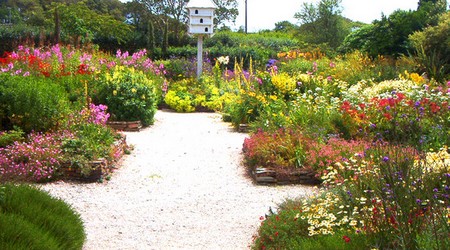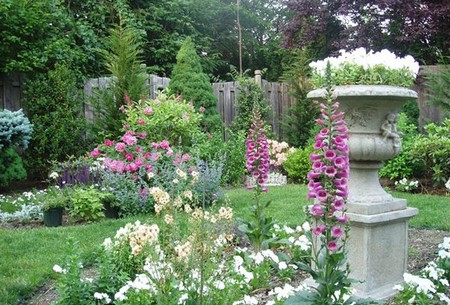Best Way to Color Your Garden with Herbaceous plants
Herbaceous plants are generally easy to grow and will repay the initial effort involved in planting them. Once established, they create magnificent displays for three to five years before being dug up, divided and re-planted into new flowering positions.
The range of herbaceous plants is wide; some have spectacular flowers, while others develop colored or variegated leaves.
Color-theme borders
Borders with flowers and leaves sharing a particular color theme were traditionally very popular. Extensive borders, often planted in pairs and positioned opposite one another, were color-themed with gold-and-yellow, orange, blue, green, or silver-and-white plants. This style can still be created, but invariably on a smaller scale.
- Gold-and-yellow: Achillea filipendulina ‘Coronation Gold’ (fern-leaf achillea): Lemon-yellow flowers.
- Alchemilla mollis (lady’s mantle): Sulphur yellow flowers and light green leaves.
- Coreopsis verticillata: Bright yellow, starlike flowers and finely-divided leaves.
- Doronicum x excelsum ‘Harpur Crewe’ (previously known as D. plantagineum ‘Excelsum’, and popularly as leopard’s bane): Single, golden-yellow, daisy-like flowers.
- Phlomis fruticosa (Jerusalem sage): Tiered whorls of bright yellow flowers.
- Rudbeckia fulgida (coneflower): Yellow to orange, 6.5cm wide flowers.
- Solidago ‘Goldenmosa’ (golden rod): Tiny, yellow flowers in feathery plumes.
- Trollius x cultorum (globe flower): Yellow to orange, large, globe-shaped flowers.
Blue and mauve:
- Aconitum napetlus (monkshood): Hooded, deep blue flowers. Several excellent varieties.
- Anchusa azurea (alkanet): Bright blue, forget-me-not-like flowers in lax heads.
- Aster amellus ‘King George’ (Italian starwort): Large, daisy-like, blue-violet flowers with golden-yellow centres.
- Aster xfrikartii: Large, daisy-like blue flowers with orange centres.
- Campanula lactiflora (milky bellflower): Lavender-blue, bell-like flowers. Chelone obliqua (turtle-head): Deep rose, snapdragon-like flowers borne in clusters.
- Echinops ritro (globe thistle): Round, steel-blue flowers up to 5cm (2in) wide.
- Incarvillea mairei (trumpet flower): Trumpet-like, pinkish-purple flowers.
- Liatrisspicata (blazing star): Pinkish-purple flowers in paint-brush heads.
- Salvia xsuperba (long-branched sage): Tall, violet-purple spires.
- Tradescantia x andersoniana ‘Isis’ (spiderwort): Purple-blue flowers.
Pink and red:
- Aster novi-belgii ‘Orlando’ (Michaelmas daisy): Semi-double pink flowers.
- Crocosmia masonorum ‘Vulcan’ (montbretia): Clusters of orange-red, trumpet-like flowers. Dicentra spectabilis (bleeding heart): Pendulous, rose-red, heart-shaped flowers. Euphorbiagriffithii ‘Fireglow’: Orange-red bracts clustered at the tops of stems.
- Hemerocallis ‘Pink Damask’ (day lily): Large, warm-pink flowers with yellow throats. Kniphofia (torch lily): Several species and varieties with red flowers in poker-like heads Schizostylis coccinea ‘Major’: Rich, vivid-crimson flowers.
Silver and white:
- Anaphalis triplinervis (pearly everlasting):
- White flowers and leaves. Artemisia ludoviciana (white sage): White leaves and silvery-white flowers.
- Leucanthemum x vulgare (previously known as Chrysanthemum maximum, and popularly as Shasta daisy): Large, white, daisy-like flowers.
- Gypsophila paniculata (baby’s breath): Massed white flowers in lax, clustered heads.
- Onopordum acanthium (ornamental thistle): Jaggedly-lobed, silvery-grey leaves.
- Romneya coulteri (tree poppy): Large, white flowers with bright golden centres. Stachys byzantina (lamb’s tongue): Oval leaves smothered in silvery-white hairs.
Categories
Advertisements
Recent Articles
 How to Understand Bed Sizes – A Small Guide
How to Understand Bed Sizes – A Small Guide How to Select Some Must Have Kitchen Accessories
How to Select Some Must Have Kitchen Accessories Best Way to Change a Car Tire
Best Way to Change a Car Tire Best Way to Write an Affirmation
Best Way to Write an Affirmation Best Way to Take Charge of Your Financial Life
Best Way to Take Charge of Your Financial Life Best Way to Survive a Party When You Don’t Know Anyone
Best Way to Survive a Party When You Don’t Know Anyone Best Way to Stop Self Sabotaging Yourself
Best Way to Stop Self Sabotaging Yourself Best Way to Start Journal Writing
Best Way to Start Journal Writing Best Way to Speak with a Powerful Voice
Best Way to Speak with a Powerful Voice Best Way to Simplify Your Life
Best Way to Simplify Your Life Best Way to Respond to a Put-Down
Best Way to Respond to a Put-Down Best Way to Reduce Acne Breakouts
Best Way to Reduce Acne Breakouts Best Way to Recover from Dining Disasters
Best Way to Recover from Dining Disasters Best Way to Quit Your Job Gracefully
Best Way to Quit Your Job Gracefully Best Way to Make Your Own Website
Best Way to Make Your Own Website




Leave a Reply